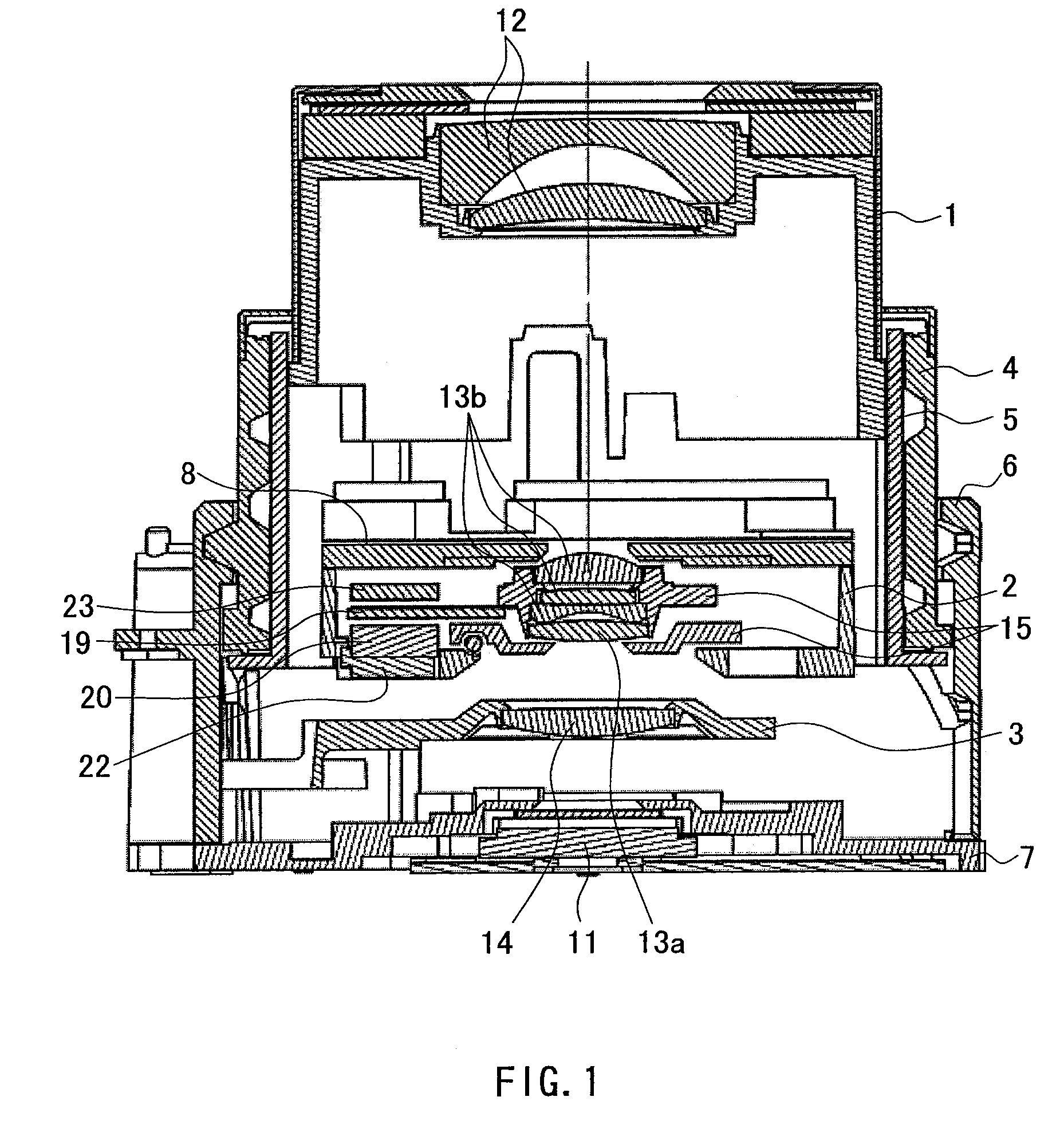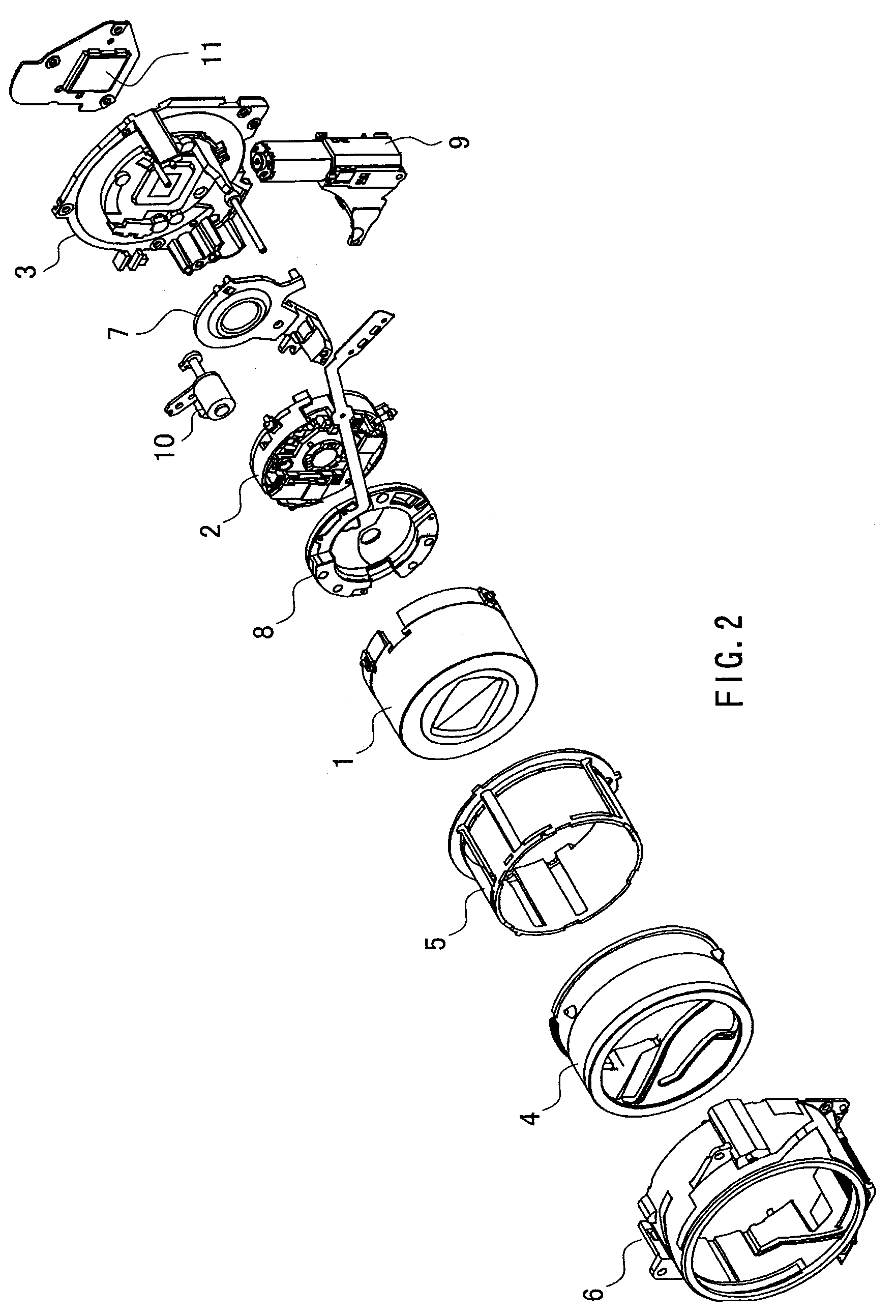Image stabilizing apparatus
a technology lens shift, which is applied in the direction of projectors, instruments, printing, etc., can solve the problems of increasing the relative material cost of magnets and difficult stabilizing the positioning of camera bodies, and achieve the effects of reducing the size and weight of image stabilizing apparatus, and reducing the size and weight of actuators
- Summary
- Abstract
- Description
- Claims
- Application Information
AI Technical Summary
Benefits of technology
Problems solved by technology
Method used
Image
Examples
embodiment 1
[1. Configuration and Operation of Image Sensing Apparatus]
[0032]FIG. 1 is a cross-sectional view of a lens barrel according to embodiment 1. FIG. 2 is an exploded perspective view of the lens barrel.
[0033]As shown in FIGS. 1 and 2, the lens barrel of embodiment 1 includes a first moving frame 1, a second moving frame 2, a third moving frame 3, a drive frame 4, a through frame 5, a fixed frame 6, and a base unit 7.
[0034]The first moving frame 1 holds a first lens group 12 that includes an objective lens. The first moving frame 1 is held movably in the optical axis direction by the drive frame 4.
[0035]The second moving frame 2 (holding frame) includes a shutter unit 8, a pitching frame 15, a laminated substrate 19, a magnet 20, a hall element 21 (see FIG. 3), a back yoke 22, an opposing yoke 23 and a flexible printed circuit board 24. The second moving frame 2 is supported by the drive frame 4 so as to be movable in the optical axis direction. The second moving frame 2 holds a second...
embodiment 2
[0079]In embodiment 2, a configuration is shown that improves on the opposing yoke of embodiment 1.
[0080]FIG. 7A is a perspective view showing an opposing yoke according to embodiment 2. FIG. 7B is a cross-sectional view of a C-C portion of FIG. 7A. Note that the configuration of the image stabilizing apparatus of embodiment 2 is the same as embodiment 1 except for the opposing yoke 31.
[0081]The opposing yoke 23 shown in embodiment 1 is stepped (indentation-type recesses 23a, 23b) up to and including an outer periphery thereof, as shown in FIG. 5. That is, the indentation-type recesses 23a and 23b are formed in the surface of the opposing yoke 23 that opposes the hall element 21 up to the edge of the opposing yoke 23 on the short side.
[0082]The opposing yoke 31 shown in embodiment 2 is only stepped (recesses 31a, 31b) in a portion of the opposing yoke 31 that opposes the hall element 21, as shown in FIG. 7B. That is, flat portions 31c and 31d that are flush with the main surface of ...
PUM
 Login to View More
Login to View More Abstract
Description
Claims
Application Information
 Login to View More
Login to View More - R&D
- Intellectual Property
- Life Sciences
- Materials
- Tech Scout
- Unparalleled Data Quality
- Higher Quality Content
- 60% Fewer Hallucinations
Browse by: Latest US Patents, China's latest patents, Technical Efficacy Thesaurus, Application Domain, Technology Topic, Popular Technical Reports.
© 2025 PatSnap. All rights reserved.Legal|Privacy policy|Modern Slavery Act Transparency Statement|Sitemap|About US| Contact US: help@patsnap.com



